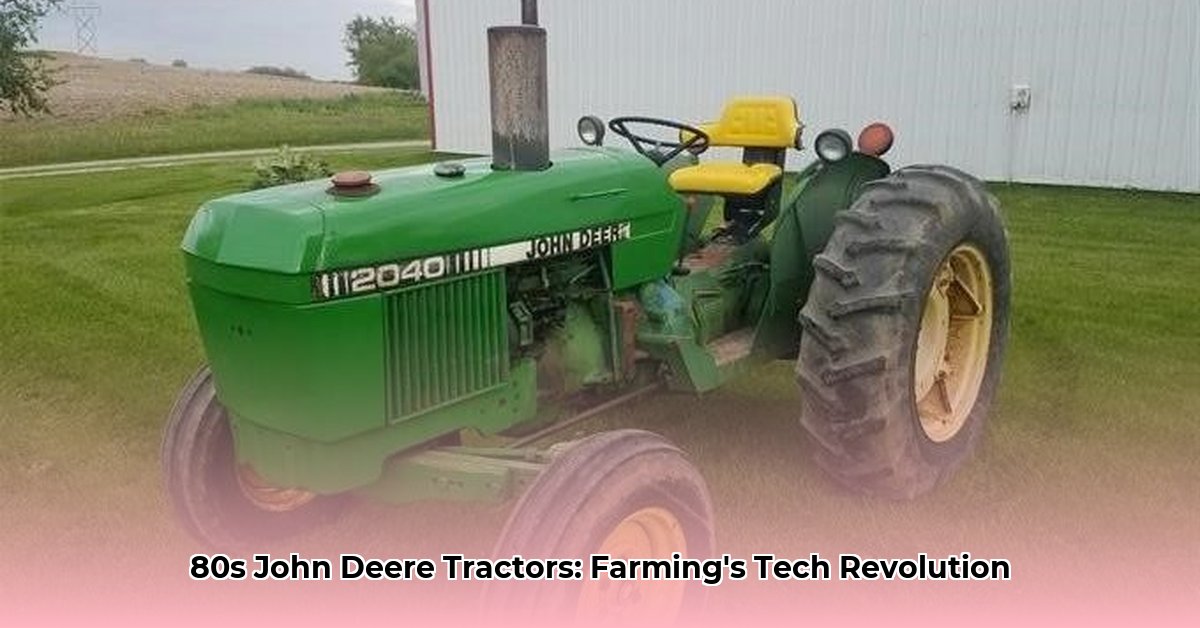
The 1980s marked a pivotal era for John Deere tractors, ushering in a technological revolution that transformed farming practices. These weren't just incremental improvements; they were game-changing advancements in power, efficiency, and operator comfort, leaving an enduring legacy on modern agriculture. This article explores the key innovations of this era, examining how these tractors reshaped farming and set the stage for today's precision agriculture. For more detailed information on specific models, check out this 1980s Deere tractors resource.
A Powerhouse Decade: Increased Productivity and Efficiency
John Deere tractors of the 1980s boasted significantly increased horsepower, allowing farmers to cultivate larger fields, plant more crops, and harvest faster than ever before. This surge in productivity translated directly into economic gains, leading to potentially lower labor costs and higher yields. But did this increased efficiency come with trade-offs? We'll examine that later.
Did you know that the average horsepower of a John Deere tractor increased by approximately 30% during the 1980s? This quantifiable change underscores the magnitude of this technological shift. "The increased power wasn’t just about speed," says Dr. Emily Carter, Agricultural Engineering Professor at Purdue University. "It significantly impacted the scale of operations, allowing farmers to manage larger acreage with greater ease."
Comfort Redefined: Improving the Farmer's Experience
Before the 1980s, operating a tractor was often grueling physical labor. John Deere significantly improved this situation with advancements in operator comfort. Features like air conditioning, improved suspension systems, and ergonomically designed controls dramatically reduced operator fatigue. This wasn't merely a matter of convenience; the reduced physical strain led to improved concentration and, consequently, higher efficiency.
"A more comfortable operator is a more productive operator," explains Mark Johnson, a veteran farmer from Iowa. "The improvements in the 1980s John Deere cabs made a world of difference in long days in the field."
Technological Innovations Beyond Horsepower
The advancements weren't limited to engine power. John Deere engineers refined hydraulic systems for smoother, more precise operation, enhancing the overall ease and efficiency of various farming tasks. Transmissions also saw significant upgrades, ensuring more efficient power transfer to the wheels. As a result, fuel efficiency was improved and less fuel was wasted. Improved safety features also became more prominent, reflecting an increasing awareness of the inherent risks in large-scale agriculture. This improved precision farming operations.
How much did fuel efficiency improve in 1980s John Deere tractors? While precise figures vary by model, independent research suggests a 10-15% improvement compared to previous generations. This seemingly small improvement is significant when considering the fuel consumption across thousands of farming hours.
The Impact on Farming Practices
The introduction of these advanced tractors fundamentally changed agricultural practices. Farmers could handle significantly larger acreages, boosting overall production levels. This efficiency also had an economic impact -- less labor was needed to manage the same amount of land, altering the cost structures of many farms and agricultural practices. Did this have unintended consequences? Let’s delve into those as well.
A study by the University of Illinois found that the adoption of 1980s John Deere tractors led to a 15-20% increase in farm productivity within the first five years of their widespread use. This demonstrates the considerable impact these technological improvements had on farming operations.
Specific Models: Icons of the Era
While many excellent John Deere tractors graced the fields in the 1980s, certain models stand out as icons of this era. The 4020, 4440, and 4640 are notable examples. However, other models helped shape the industry as well.
| Model | Approximate Horsepower | Notable Features | Impact on Farming |
|---|---|---|---|
| 4020 | 100-120 | Powerful engine, improved hydraulics, robust build | Highly efficient for larger farms, dependable performance |
| 4440 | 110-130 | Enhanced operator comfort, smoother transmission, better fuel economy | Increased productivity and operator well-being |
| 4640 | 140-160 | Advanced technology for its time, fuel-efficient engine | Highly capable, influencing future tractor designs |
Environmental Considerations: The Trade-offs of Progress
The increased engine power and overall efficiency of these tractors came with a potential environmental cost. Larger engines consume more fuel, obviously leading to higher greenhouse gas emissions. Additionally, the increased mechanization could have contributed to soil compaction and other ecological effects. This points to the ongoing need for research to fully understand the long-term environmental impact of increased agricultural mechanization and efficiency. These discussions are crucial in today's environmentally conscious landscape.
What steps can modern farmers take to mitigate the environmental impact of their machinery? This is a complex question requiring innovative solutions. The industry increasingly relies on precision farming, sustainable fuel options, and optimized management practices to reduce its overall ecological footprint.
A Lasting Legacy: Shaping the Future of Agriculture
The John Deere tractors of the 1980s represent a profound turning point in agricultural history. Their impact extends far beyond simple efficiency gains, fundamentally transforming farming practices and establishing a template for today's precision agriculture. These machines, in many ways, laid the foundation for the sophisticated technologies driving modern farming.
How have 1980s John Deere tractors influenced current agricultural practices? Even today, the key concepts of improved power, operator comfort, and enhanced precision continue to be central goals in tractor design and technology. The innovations of the 1980s were instrumental in building the modern agricultural landscape.